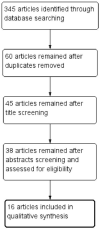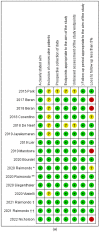The Use of near Infra-Red Radiation Imaging after Injection of Indocyanine Green (NIR-ICG) during Laparoscopic Treatment of Benign Gynecologic Conditions: Towards Minimalized Surgery. A Systematic Review of Literature
- PMID: 35744056
- PMCID: PMC9231050
- DOI: 10.3390/medicina58060792
The Use of near Infra-Red Radiation Imaging after Injection of Indocyanine Green (NIR-ICG) during Laparoscopic Treatment of Benign Gynecologic Conditions: Towards Minimalized Surgery. A Systematic Review of Literature
Abstract
Background and Objectives: To assess the use of near infrared radiation imaging after injection of indocyanine green (NIR-ICG) during laparoscopic treatment of benign gynecologic conditions. Materials and Methods: A systematic review of the literature was performed searching 7 electronic databases from their inception to March 2022 for all studies which assessed the use of NIR-ICG during laparoscopic treatment of benign gynecological conditions. Results: 16 studies (1 randomized within subject clinical trial and 15 observational studies) with 416 women were included. Thirteen studies assessed patients with endometriosis, and 3 studies assessed non-endometriosis patients. In endometriosis patients, NIR-ICG use appeared to be a safe tool for improving the visualization of endometriotic lesions and ureters, the surgical decision-making process with the assessment of ureteral perfusion after conservative surgery and the intraoperative assessment of bowel perfusion during recto-sigmoid endometriosis nodule surgery. In non-endometriosis patients, NIR-ICG use appeared to be a safe tool for evaluating vascular perfusion of the vaginal cuff during total laparoscopic hysterectomy (TLH) and robotic-assisted total laparoscopic hysterectomy (RATLH), and intraoperative assessment of ovarian perfusion in adnexal torsion. Conclusions: NIR-ICG appeared to be a useful tool for enhancing laparoscopic treatment of some benign gynecologic conditions and for moving from minimally invasive surgery to minimalized surgery. In particular, it might improve treatment of endometriosis (with particular regard to deep infiltrating endometriosis), benign diseases requiring TLH and RATLH and adnexal torsion. However, although preliminary findings appear promising, further investigation with well-designed larger studies is needed.
Keywords: fluorescence; fluorescent dye; gynecology; innovation; laparoscopy; minimally-invasive; technology.
Conflict of interest statement
The authors declare no conflict of interest.
Figures



Similar articles
-
Role of fluorescence imaging for intraoperative intestinal assessment in gynecological surgery: a systematic review.Minim Invasive Ther Allied Technol. 2022 Oct;31(7):992-999. doi: 10.1080/13645706.2022.2064715. Epub 2022 Apr 20. Minim Invasive Ther Allied Technol. 2022. PMID: 35442833
-
Indocyanine green near-infrared fluorescence bowel perfusion assessment to prevent anastomotic leakage in minimally invasive colorectal surgery (AVOID): a multicentre, randomised, controlled, phase 3 trial.Lancet Gastroenterol Hepatol. 2024 Oct;9(10):924-934. doi: 10.1016/S2468-1253(24)00198-5. Epub 2024 Aug 13. Lancet Gastroenterol Hepatol. 2024. PMID: 39151436 Clinical Trial.
-
Fluorescence-guided ureteral identification in robotic surgery for advanced endometriosis: a comparison of junior versus senior surgeons.Sci Rep. 2025 Jun 6;15(1):19933. doi: 10.1038/s41598-025-05082-1. Sci Rep. 2025. PMID: 40481106 Free PMC article.
-
Indocyanine green and infrared fluorescence in detection of sentinel lymph nodes in endometrial and cervical cancer staging - a systematic review.Eur J Obstet Gynecol Reprod Biol. 2016 Nov;206:213-219. doi: 10.1016/j.ejogrb.2016.09.027. Epub 2016 Sep 30. Eur J Obstet Gynecol Reprod Biol. 2016. PMID: 27750179
-
Fluorescence indocyanine green (ICG) for sentinel-lymph-node mapping in colorectal cancer: a systematic review.Langenbecks Arch Surg. 2025 Jul 1;410(1):202. doi: 10.1007/s00423-025-03786-6. Langenbecks Arch Surg. 2025. PMID: 40590942 Free PMC article.
Cited by
-
Near-Infrared Fluorescence-Guided Segmentectomy: Added Benefit of Indocyanine Green Dye Diminishes With Surgeon Experience.Surg Innov. 2025 Jun;32(3):211-221. doi: 10.1177/15533506251315979. Epub 2025 Jan 22. Surg Innov. 2025. PMID: 39844504 Free PMC article. Clinical Trial.
-
A Potential Pitfall in the Interpretation of Microscope-Integrated Fluorescence Angiography: The Center-Periphery Effect.Med Sci (Basel). 2025 May 3;13(2):54. doi: 10.3390/medsci13020054. Med Sci (Basel). 2025. PMID: 40407549 Free PMC article.
-
A Green Lantern for the Surgeon: A Review on the Use of Indocyanine Green (ICG) in Minimally Invasive Surgery.J Clin Med. 2024 Aug 19;13(16):4895. doi: 10.3390/jcm13164895. J Clin Med. 2024. PMID: 39201036 Free PMC article. Review.
-
Innovative ICG Application in Benign Gynaecological Surgery: Enhancing Safety and Precision.Case Rep Obstet Gynecol. 2024 Jul 26;2024:1642315. doi: 10.1155/2024/1642315. eCollection 2024. Case Rep Obstet Gynecol. 2024. PMID: 39105141 Free PMC article.
-
Intraoperative Utilization of Indocyanine Green (ICG) Dye for the Assessment of Ovarian Perfusion-Case Report and Review of the Literature.J Clin Med. 2023 Sep 12;12(18):5923. doi: 10.3390/jcm12185923. J Clin Med. 2023. PMID: 37762865 Free PMC article.
References
-
- Raimondo D., Borghese G., Mabrouk M., Arena A., Ambrosio M., Del Forno S., Degli Esposti E., Casadio P., Mattioli G., Mastronardi M., et al. Use of Indocyanine Green for Intraoperative Perfusion Assessment in Women with Ureteral Endometriosis: A Preliminary Study. J. Minim. Invasive Gynecol. 2021;28:42–49. doi: 10.1016/j.jmig.2020.04.004. - DOI - PubMed
-
- Raimondo D., Mastronardi M., Mabrouk M., Cafagna G., Salucci P., Arena A., Iodice R., Borghese G., Casadio P., Del Forno S., et al. Rectosigmoid Endometriosis Vascular Patterns at Intraoperative Indocyanine Green Angiography and their Correlation with Clinicopathological Data. Surg. Innov. 2020;27:474–480. doi: 10.1177/1553350620930147. - DOI - PubMed
-
- Tajima Y., Murakami M., Yamazaki K., Masuda Y., Kato M., Sato A., Goto S., Otsuka K., Kato T., Kusano M. Sentinel node mapping guided by indocyanine green fluorescence imaging during laparoscopic surgery in gastric cancer. Ann. Surg. Oncol. 2010;17:1787–1793. doi: 10.1245/s10434-010-0944-0. - DOI - PubMed
Publication types
MeSH terms
Substances
LinkOut - more resources
Full Text Sources
Medical
Miscellaneous

